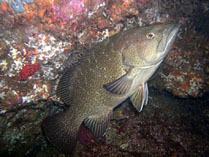| Family: |
Epinephelidae (Groupers) |
| Max. size: |
86 cm TL (male/unsexed); max.weight: 9,640.0 g |
| Environment: |
reef-associated; marine; depth range 1 - 50 m |
| Distribution: |
Eastern Central Pacific: southwest coast of Baja California throughout the Gulf of California to Jalisco, Mexico. |
| Diagnosis: |
Dorsal spines (total): 11-11; Dorsal soft rays (total): 16-18; Anal spines: 3-3; Anal soft rays: 10-11. Distinguished by the following characteristics: greenish to greyish brown body color with small reddish brown spots and irregular pale spots and lines; fins with white margins; small portion of population exhibit xanthic pattern which is entirely bright yellow-orange, sometimes with few irregular black spots; depth of body contained 2.7-3.1 times in SL; head length 2.6-2.8 times in SL; angle of preopercle in adults with weakly-developed serrate lobe; posterior nostrils of large adults 2-3 times larger than anterior ones (Ref. 89707). |
| Biology: |
Prefers rocky areas in shallow water at depths of about 50 m. Adults feed on schools of the flatiron herring, Harengula thrissina, and anchoveta, Cetengraulis mysticetus when available; if not, on other schooling fishes or non-schooling fishes. Most feed at dawn and dusk, with a peak in activity about 20 minutes after sunset. Juveniles feed throughout the day on a variety of benthic fishes and crustaceans. |
| IUCN Red List Status: |
Least Concern (LC); Date assessed: 18 November 2016 Ref. (130435)
|
| Threat to humans: |
harmless |
| Country info: |
|
Source and more info: www.fishbase.org. For personal, classroom, and other internal use only. Not for publication.

